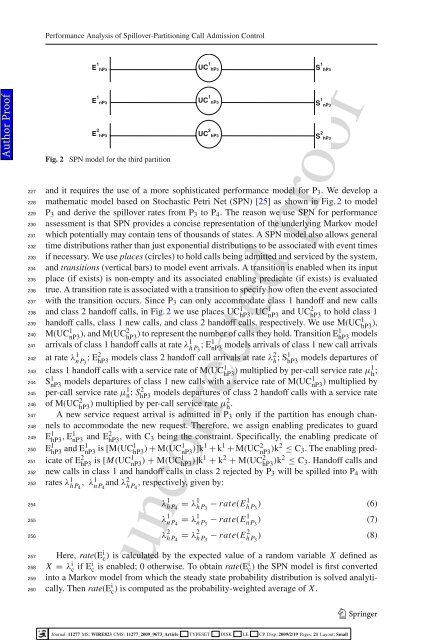Dear Author, Here are the proofs of your article. ⢠You can submit ...
Dear Author, Here are the proofs of your article. ⢠You can submit ...
Dear Author, Here are the proofs of your article. ⢠You can submit ...
- No tags were found...
Create successful ePaper yourself
Turn your PDF publications into a flip-book with our unique Google optimized e-Paper software.
Performance Analysis <strong>of</strong> Spillover-Partitioning Call Admission Control<strong>Author</strong> Pro<strong>of</strong>E 1 hP3E 1 nP3E 2 hP3Fig. 2 SPN model for <strong>the</strong> third partitionUC 1 hP3UC 1 nP3UC 2 hP3227 and it requires <strong>the</strong> use <strong>of</strong> a more sophisticated performance model for P 3 .Wedevelopa228 ma<strong>the</strong>matic model based on Stochastic Petri Net (SPN) [25] as shown in Fig. 2 to model229 P 3 and derive <strong>the</strong> spillover rates from P 3 to P 4 . The reason we use SPN for performance230 assessment is that SPN provides a concise representation <strong>of</strong> <strong>the</strong> underlying Markov model231 which potentially may contain tens <strong>of</strong> thousands <strong>of</strong> states. A SPN model also allows general232 time distributions ra<strong>the</strong>r than just exponential distributions to be associated with event times233 if necessary. We use places (circles) to hold calls being admitted and serviced by <strong>the</strong> system,234 and transitions (vertical bars) to model event arrivals. A transition is enabled when its input235 place (if exists) is non-empty and its associated enabling predicate (if exists) is evaluated236 true. A transition rate is associated with a transition to specify how <strong>of</strong>ten <strong>the</strong> event associated237 with <strong>the</strong> transition occurs. Since P 3 <strong>can</strong> only accommodate class 1 hand<strong>of</strong>f and new callsand class 2 hand<strong>of</strong>f calls, in Fig. 2 we use places UC 1 hP3 , UC1 nP3 and UC2 hP3to hold class 1hand<strong>of</strong>f calls, class 1 new calls, and class 2 hand<strong>of</strong>f calls, respectively. We use M(UC 1 hP3 ),M(UC 1 nP3 ), and M(UC2 hP3 ) to represent <strong>the</strong> number <strong>of</strong> calls <strong>the</strong>y hold. Transition E1 hP3 modelsarrivals <strong>of</strong> class 1 hand<strong>of</strong>f calls at rate λ 1 hP 3; E 1 nP3models arrivals <strong>of</strong> class 1 new call arrivals242 at rate λ 1 nP 3; E 2 hP3 models class 2 hand<strong>of</strong>f call arrivals at rate λ2 h ; S1 hP3models departures <strong>of</strong>243 class 1 hand<strong>of</strong>f calls with a service rate <strong>of</strong> M(UC 1 hP3 ) multiplied by per-call service rate µ1 h ;S 1 nP3 models departures <strong>of</strong> class 1 new calls with a service rate <strong>of</strong> M(UC1 nP3) multiplied byper-call service rate µ 1 n ; S2 hP3models departures <strong>of</strong> class 2 hand<strong>of</strong>f calls with a service rate<strong>of</strong> M(UC 2 hP3 ) multiplied by per-call service rate µ2 h .247 A new service request arrival is admitted in P 3 only if <strong>the</strong> partition has enough chan-248 nels to accommodate <strong>the</strong> new request. Therefore, we assign enabling predicates to guard249 E 1 hP3 , E1 nP3 and E2 hP3 , with C 3 being <strong>the</strong> constraint. Specifically, <strong>the</strong> enabling predicate <strong>of</strong>250 E 1 hP3 and E1 nP3 is [M(UC1 hP3 )+M(UC1 nP3 )]k1 + k 1 + M(UC 2 nP3 )k2 ≤ C 3 . The enabling pred-251 icate <strong>of</strong> E 2 hP3 is [M(UC1 nP3 ) + M(UC1 hP3 )]k1 + k 2 + M(UC 2 hP3 )k2 ≤ C 3 . Hand<strong>of</strong>f calls and252 new calls in class 1 and hand<strong>of</strong>f calls in class 2 rejected by P 3 will be spilled into P 4 with253 rates λ 1 hP 4,λ 1 nP 4and λ 2 hP 4, respectively, given by:254255256S 1 hP3S 1 nP3S 2 hP3λ 1 hP 4= λ 1 hP 3− rate(E 1 hP 3) (6)λ 1 nP 4= λ 1 nP 3− rate(E 1 nP 3) (7)λ 2 hP 4= λ 2 hP 3− rate(E 2 hP 3) (8)uncorrected pro<strong>of</strong><strong>Here</strong>, rate(E i 257 c ) is calculated by <strong>the</strong> expected value <strong>of</strong> a random variable X defined asX = λ i 258 c if Ei c is enabled; 0 o<strong>the</strong>rwise. To obtain rate(Ei c ) <strong>the</strong> SPN model is first converted259 into a Markov model from which <strong>the</strong> steady state probability distribution is solved analytically.Then rate(E i c ) is computed as <strong>the</strong> probability-weighted average <strong>of</strong> X.260 123Journal: 11277 MS: WIRE823 CMS: 11277_2009_9673_Article TYPESET DISK LE CP Disp.:2009/2/19 Pages: 21 Layout: Small
















